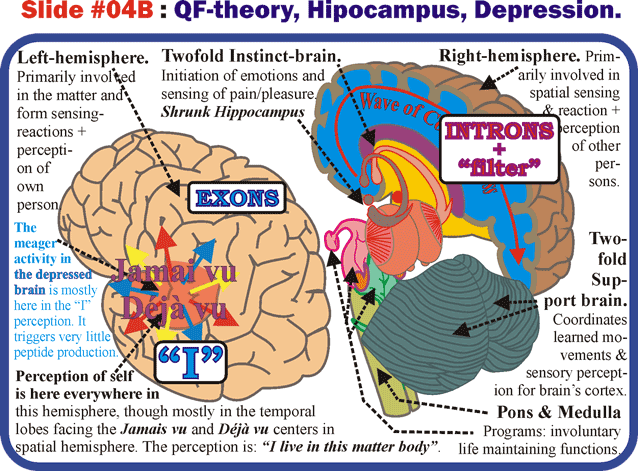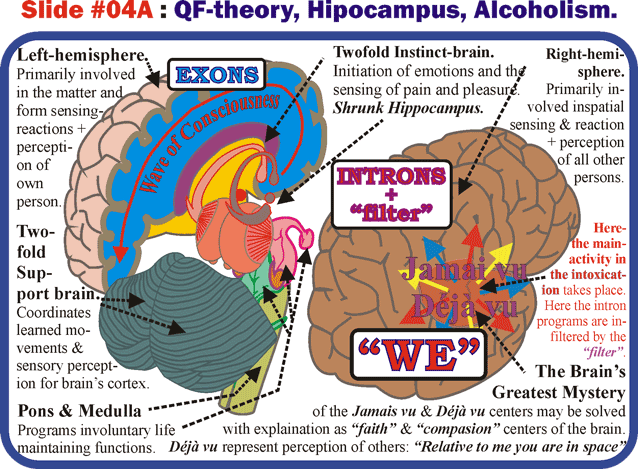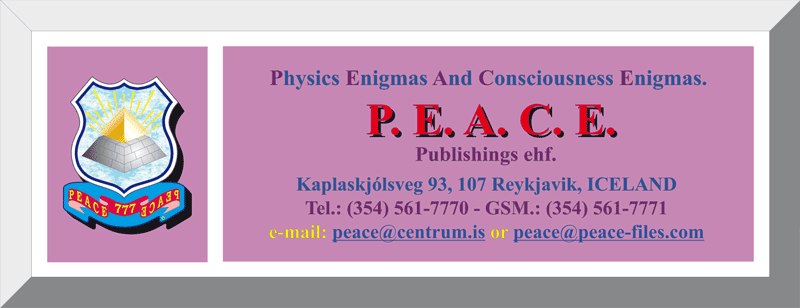 |
The Physics Enigmas And Consciousness Enigmas Files "The PEACE-Files" P. E. A. C. E.
|

The
QF- Letters-Essays!
The two Kinds
of Hippocampal
Volume Loss!
This file presents a part of a series of open letters depicting in the simplest manner possible, the initial findings of the QF-theory, presented in the 2002 published book THE LITTLE SCROLL and in the PEACE-Files. The QF-theory is a Complete Unification Theory in physics that includes the Observer, Life and Consciousness and is thus claimed as a
Theory of Everything
The
QF-Letters and their Subjects are:
| The QF : INTRODUCTIONS: | The
Initial
Findings of Man's
Greatest
Search: The QF-Ultimate Theory of Everything! |
| The First QF Letter: |
The Alternate Set-Mathematical Solution offered by: The QF-theory of Everything! |
| The Second QF Letter: |
The End of Theoretical Physics and the 6-dimensional QF-theoretical paradigm! |
|
The Third QF Letter: |
The QF-theory, the Parallel Universes Theories and The Limits of Mathematics! |
| The Fourth QF Letter: |
God
on the Brain and The
Riddle
of God and the Brain Neurological and Psychological Quagmire!
|
|
The Fifth QF Letter: |
From
the Riddle of
Désjà
vu, to the Riddle of the Autism Mystery!
|
|
The Sixth QF LETTER: |
The two Kinds of Hippocampal Volume Loss in Depressive and Alcoholic Individuals! |
|
The Seventh QF Letter: |
After the Genome! After the Double Helix! The Cancer and Consciousness connection! |
| The Eighth QF Letter: |
Life, Cancer and the Organization of Procaryot and Eucaryot DNA matching the Human Brain. |
| The Ninth QF Letter: |
The
QF-theory of the Brain's Empathy Center and its connections to Wars and
Crimes in Humanity. |
| The Tenth QF Letter: |
Sir Isaac Newton, the Rainbow and the QF-theory's Fundamental Color explaination. |
| The
Eleventh QF Letter: |
The QF-theory and the Riddles of the Double Slit Experiment! |
| The Twelfth QF Letter: |
The
Solution to One of Humanities oldest Riddle. The Interview with the Mysterious Mr. 666. |
“Since the brain is
unlike
any other structure in the known universe, it seems reasonable to
expect
that our understanding of its functioning--if it can
ever be
achieved--will
require approaches that are drastically
different from the way we
understand
other physical systems.
This is not a call fornihilism, but humility.”
The Sixth QF-Letter:
The QF Brain-theory
and
The Two Kinds of
Hippocampal
Volume Loss!
Depression Hippocampal Volume Loss
http://kevxml2a.infospace.com/_1_300313__info.alltel/health/hlt-story.htm&qid=517182&qt=1
Depressed Adolescents
Have Altered
Brain Structure.
Study finds hippocampus
is
smaller.
By Steven Reinberg
HealthDay
Reporter
The hippocampus is associated with motivation, emotional control and memory, and plays a role in controlling the body's response to stress, MacMaster says. Results of studies that measured the size of the hippocampus in adults with depression have disagreed about whether there is a difference in hippocampal size between healthy and depressed adults. In this first study to measure hippocampal size in teens, researchers studied 34 adolescents aged 13 to 18. Seventeen of the patients had major depressive disorder, while the others didn't. All the teens had a magnetic resonance imaging (MRI) scan, and the researchers measured the volume of their left and right hippocampus. The investigators found the hippocampus of teens with major depressive disorder was, on average, 17 percent smaller than the non-depressed teens. This size difference was particularly prominent in the left hippocampus, they report. "I was surprised by the amount of difference in hippocampal size, which is on the high side of the hippocampal size difference seen between depressed and healthy adults," MacMaster says. MacMaster believes these results indicate there is a genetic component to major depression, which probably involves several genes. "But we have not found the smoking gun gene yet," he says. With drugs and other interventions, the prognosis of depression in teens is hopeful, MacMaster says. "Becoming aware of a child's depression is the real front line from a clinical point of view," he adds.
The goal of this research is to identify biomarkers that will aid doctors in diagnosing adolessent depression, he says. MacMaster stresses that depression in adolescents "is a biological, medical condition. It's not a character flaw arising from poor parenting." Dr. Joseph L. Price, a professor of anatomy and neurobiology at Washington University in St. Louis, says other studies have found differences in hippocampal volume in older patients with major depression. And some studies have found that women with major depression had a smaller corpus callosum, which connects the left and right halves of the brain. The same thing was found in the children of these women, indicating that they, too, have an increased risk for depression, Price says. Price adds that, in his own work, he has found changes in some types of brain cells in people with major depression compared to healthy patients.
Taken together, all these studies "indicate that there are several physical changes in the brain that underlie major depression," Price says. "All this might not help us treat the disease, but it will help us understand it." Dr. Hillary Blumberg, an assistant professor of psychiatry at Yale University, adds this study is important because it may lead to identifying a biological marker that can diagnose depression in teens. "This is a very hopeful message, because it suggests that we are developing a better sense of where to look in the brain to understand the development of depression." And this may lead to better treatment, she says.
Alcoholic
Hippocampal
Volume
Loss
http://www.uku.fi/neuro/bl0101.htm
University of KUOPIO : Deaprtment of Neuro Science Bullietin.
Kuopio, Finland - February 26. 2001. Magnetic resonance imaging (MRI) of the hippocampus has been extensively studied on neurological and psychiatric disorders. Particularly in studies on schizophrenia and mood disorders, findings regarding the hippocampal involvement have been most controversial. Previously, minor volume loss of the hippocampus in alcoholism, a major comorbidity alongside psychiatric disorders, has been reported. No data has existed on the hippocampal volumes in subtypes of alcoholism, despite the need and interest to further identify and study subgroups of alcoholics with psychiatric and behavioral syndromes that occur outside and within the context of their abuse. In this case, the distinction was drawn to alcoholism with and without antisocial and violent behavior. In the first of the two studies, MRI was used to measure volumes of the hippocampus in late-onset type 1 alcoholics and early-onset type 2 alcoholics. Of these, the type 1-alcoholism is typically characterized to represent late-onset alcoholism with substantially preserved social and occupational behavior, and relatively intact impulse control. These subjects are typically characterized as anxietyprone personalities, typically with the alcoholism consisting of alternating periods of binges and abstinence. The type 1 alcoholics were recruited from a local rehabilitation center. In contrast, the type 2 alcoholics represent early-onset alcoholism, and their behavior is characterized by euphoria-seeking personality, which is typically associated with impulsive, criminal, antisocial and violent behavior. The type 2 alcoholic subjects were also violent offenders with antisocial personality disorder, derived from a forensic psychiatric sample. All had a history of violent episodes, several of them were in custody because of homicide, but all were diagnosed non-psychotic and legally competent.
Compared to the controls, the right hippocampal volumes were significantly smaller in both alcoholic groups. While there was no correlation between the hippocampal volumes with age in the control subjects, there was tendency towards decreased volumes with ageing and also with the duration of alcohol-ism in the type 1 alcoholic subjects. This suggests that alcoholism without major psychiatric or other com-orbidities is associated with decline in hippocampal volumes. On the contrary, there was a significant positive correlation between right hippocampal volume, age and duration of alcoholism in type 2 alcoholics.
Because the study was cross-sectional, it would be premature to conclude that alcohol and polysub-stance abuse, violence, and antisocial lifestyle would actually increase the hippocampal volumes, other alternatives had to be sought. From the introduction of the type 1 versus 2 dichotomy the question has remained whether the type 2 category is representative of primary alcoholism or only secondary or symptomatic to an underlying antisocial personality disorder. These effects suggest that there are profound biological differences between the two alcoholic groups, and raise the possibility that the observed effects within the type 2 category are due to other factors than the cumulative acquired effects related to alcohol abuse, such as primary personality psychopathology. The study thus provides further evidence that type-1 alcoholism, in general, is associated with a minor loss in hippocampal volume. It is also suggested that type 2 alcoholism, in general, similarly displays a minor decrease in hippocampal volume, but this decrease is unevenly distributed within the type 2 category, being weighted towards the younger subjects. The possibility that differences in degree of psychopathy would explain the findings in the type 2 alcoholics - the positive correlation between the hippocampal volumes and age - was studied in a the latter of the studies. It was hypothesized that subjects in their early twenties would be likely to display higher degree of psychopathy, being natural born killers, delinquente nato, than those who are being examined in their forties in forensic psychiatric evaluation due to violent offending. The degree of subjects' psychopathy was studied using the Psychopathy Checklist - Revised (PCL-R) and an inverse correlation was found - the smaller the hippocampi, the more severe the degree of psychopathy. The strongest correlations were found in the posterior hippocampus. The posterior hippocampus is known to participate in processes, such as conditioning and forming associations. This is the first study to date to find structure-function (or structure-malfunction) correlation in terms of degree of psychopathy. A prototypical psychopath may be impoverished in conditioning, which may be the simplest form of association process. Thus a prototypical psychopath may not learn from making mistakes. Wrong-doing in psychopath does not activate [autonomic] mechanisms that say; "if you do this, punishment follows". Hippocampus may thus play a crucial role learn in socialisation, or as is the case in psychopaths, lack thereof.
The QF-theory
and the most
Vicious Mental
Conditions of
Man!
QF-hypothesis for Hippocampal Volume Loss
Comparative analyses of the relationship between Magnetic Resonance Imaging (MRI) for "Alcoholic and Depression Hippocampal Volume Losses" findings, based in the QF-theory models for the construction and functions of the human brain. The models are founded in QF-theory discovered "filter", disturbing healthy brain functions. The QF-models for the brain and it's functions are founded in quantum mechanical models of "The First Second of Creation", producing a symmetry for the "Quantum Wave of the Universe" at "The End of the Birth of Time", or at Second 10-36 in the creation process.
In the last ten years MRI-brain research on numerous subjects has revealed considerable shrinkage of hippocampuses in the brains of alcoholics and depressives. The researchers were in both cases unable to determine whether the loos of mass, was the cause of the respective disorder, or the result of it. It was another case of medical researchers old riddle: Which came first, the chicken or the egg? The reason for this is in the simple fact that our neuro-sciences have no comprehensive working models for normal or abnormal brain functions.
General
shrinking of the brain and shrinkage of
specific
parts of the brain.
In these analyses reference is made to one of the
fundamental
dictums of neuro-physiology, which states: "If
you don't use it, you loose it!" This means that if we
are
not using some specific parts of our brains, it will result in that
part
not creating any neurotransmitters, or making electrical discharges and
consequently not exchanging any neurotransmitters. In turn this means
that
they will not be rewarded in supplies of "food" in terms
of excitatory (work energy food) or inhibitory (sustenance food)
neurotransmitters.
The sustenance neuro- transmitters--according to the QF-theory--are
the endorphin and dopamine neuro-transmitters. Hippocampal volume
shrinkage
is thus caused by disturbance in the work-processes of the brain's
hemispheres,
but this work-process is generally known as thinking.
A global shrinkage occurs in the brains of far-advanced alcoholics, who have reached the delirium-tremens stage. The neuronal death, which is known as "polyneuropathy", starts occurring, after the individual begins going into fourth-stage alcoholism withdrawal convulsion seizures, which are caused by severe absence of neuro-inhibitors in the central nervous system, rather than the presence of the alcohol toxin. This produces the so-called "wet-brain" where the shrinkage increases the volume of the ventricles, but it should be made clear that this is not the same process that causes the specific hippocampal shrinkage in the alcoholic.
The
QF-model
for
the twofold system of neuro-transmitter production.
To achieve a simplistic insight into the fundaments
of
the QF-models explanations
for
the two types of hippocampal shrinkage, an overview of its
classification
of the brain's neurotransmitter production into two categories is
necessary.
These two categories are classified as: The
Primary and The Secondary
Neurotransmitter
Productions. Here The Primary system is the one that
serves
(feeds) the Autonomic Nervous System through the
thalamus
and the hypothalamus regulation of the functions of the pituitary
gland,
which takes place mostly while we sleep. The
Secondary is then the one that regulates the brain
functions
of consciousness. This is an extremely complexed arrangement that
include
the adjustment of the reality perceptions and the reactions to reality,
through the thought process. According to the QF-model,
the thought processes are taking place in the quantum-field of the
electro-magnetic
wave of consciousness, with the neuronal electric discharges being a
secondary
action in the thought-function of consciousness. It is this field that
renders the reality of the DNA-structures in the 24 to
30.000.000.000
neurons in the seat of consciousness, into one "two-fold"
reality.
The new insights offered by the QF-models,
into the quantum-reality nature of the field of consciousness adds to
the
already known nature of the "photon", which are the boson-quanta of the
electromagnetic field. The current wisdom is that the photon has a "matter-side"
and an "antimatter side",
or
that it is practically the only particle that represents both matter/-
energy realities in one, as it flips, back and forth, at the speed of
light,
between the two zero- point virtual energy poles of the vacuum. What
the QF-theory
adds and improves on this is the insight that the photon's "matter-side"
represents a reality that is constantly moving "out"
from an unspecified center and that the "antimatter-side"
is constantly moving "inn"
towards
an unspecified center. This means that the quantum-field of the
electro-magnetic
wave of consciousness represents two separate realities in one, one
constantly
moving "out", the other
moving
constantly "inn", and that
they
do this without interfering with each other, but Professor
Eduard
Witten has shown mathematically that this is possible. This is
the foundation for the ability of the brain's consciousness to be "receiving"
holistic-photon quanta from the sensory organs, the instinct programs
in
the limbic system as well as "extracting" holistic-
photon
memory quanta from the atomic-orbits of the DNA nucleotide basis, while
it at the same time can be "depositing" holistic-photon memory quanta
into
the DNA nucleotide basis atomic-orbits. In this model the neuronal DNA,
which is interacting with the quantum-field of consciousness, is
triggered
to make an electric discharge accordingly and thus goes through the "exchange"
of neurotransmitters (commerce), at the same time as the "depository
polarity" of the neurons is regulated by this, between the
DNA's "exon"
and the "intron"
nucleotides.
Without going further into the complexities of these processes here, it should become obvious that this is suggesting that the regulation of the neuro-transmitter production in The Secondary System--or rather that the functions of the homeotic genes in the polymerisation--is through the contents of thought in the thought processes. This is thus the foundation for the QF-theories interpretation of the reasons for the MRI-scanner found hippocampal shrinkage in the last decade. In continuation of this, the QF-theory does thus not only explain why no drugs will ever work in "curing" the disorders of alcoholism and depression, but further shows--in the terms of quantum mechanics--why it is that the brains in human beings, progress into states where they can no longer produce the vital neurotransmitters. A state, in which they loose the symmetry in the reality perception to such a degree that, the alcohol and depression syndromes take over their lives and eventually destroy them.
"The investigators found the hippocampus of teens with major depressive disorder was, on average, 17 percent smaller than the non-depressed teens. This size difference was particularly prominent in the left hippocampus, they report." The QF-models for the malfunctioning brain in the depression syndrome is founded in the QF-research finding that the "exons" in the neurons of the matter hemispheric (usually the left) side and in particular the temporal lobe, contain the personal "I", or self-perception of the individual. In simplicity this is founded in that fact that "I" live in the material body and that being my prime matter reality perception, the neurons in this hemisphere contain collectively the perception of the self. This is the reason for no specific center for the self-perception having ever been found. The QF-model then suggest an erroneously deposited holistic-photon quanta in the "introns" of the neurons of the spatial hemispheric (usually the right) side and in particular the temporal lobe, contain the "WE" perception or the collective perception connecting to other humans. This erroneously deposited holistic-photon quanta represents a copy of the programs for the "exons" in the neurons of the matter hemispheric (usually the left) side and in particular the temporal lobe, contain the personal "I" perception of the individual. This erroneous program is in the QF- theory referred to as the "filter" (a term taken from the experience of the early quantum pioneers), is the cause for the depression syndrome (alcoholism as well). The term for the filter in the psychological and psychiatric professions are "functional disturbances", "functional disorders" or "super ego", but in the religions it is known by numerous spiritual terms anywhere from "negative karma", to the spirit title of "evil", usually referred to as "The Devil". The "filter" is transmitted through the generations in accordance with the Mendelian lawsof genetic inheritance propagation and the individual inheriting it usually starts adding to it early in his life through his lifestyle. Originally, this "filter" is formed through the consumption of chemicals that serve as "false-neuro- transmitters", but how it works in the brain functions is a lengthy process to describe.
 |
Most alcoholic individuals start their use of alcohol out of such an "inherited filter", or "acquired environmental filter" semi-depressive condition and learn to "self-medicate", or treat it by consuming some form of "counterfeit neuroinhibitors". For the beginner the use of small amounts of alcohol initially trigger a profuse production of endorphins and dopamines, which literally flood the brain, producing a pleasant state of high and relatively little "hangover" symptoms. This "first in life" effects of the alcohol are mostly a natural high, which usually produces the sensation: "This is what I have been missing! This is what I shall do again!" The alcohol consumption then increases the amount of "filter" in the "introns" of the neurons of the spatial hemisphere resulting in a decreased "natural flooding action" and the requirement for increased drinking in order to attain the same state of high. This is known as the increased alcohol tolerance of the, to be, alcoholic. Those who, for some reason, do not adapt to the use of counterfeit neurotransmitters may be doomed to becoming severely affected with the depression sickness. It is assumed that shrinkage is also taking place in the matter hemisphere as a whole, but since it is so much more massive than the hippocampus, it is not significant.
"Compared to the controls, the right hippocampal volumes were significantly smaller in both alcoholic groups." The quantum-mechanical process in the causes for the hippocampal shrinkage in the alcoholic syndrome is a lot simpler case than that of the depressive syndrome. However, it is founded in the same "filter" that causes the depressive syndrome. As was stated in the discussion on the depressive syndrome, the alcoholic is an individual who is initially in shortage of natural neuro- inhibitors and who learns to compensate with counterfeit chemicals. About 36% of those who try alcohol already possess a filter that will now grow and eventually lead them into the addiction syndrome. Today about 25% of the population of western cultures are addicted: 15% to alcohol, 5% to illegal drugs and 5% to the abuse of pharmaceuticals.
 |
As in the case of the depression syndrome, the "filter"
in the alcoholic "reduces"
the
spatial hemispheric "intron"
functions of the Jamais vu-faith faculties
and the Déjà vu-compassion
faculties
of the brain. As these are the prime triggers of the endorphin and
dopamine
neuro- transmitter faculties of the brain, it means neuronal starvation
of these peptides at which the addict has become an expert at
compensating
for with his substances of abuse. During each drinking spree some
peptides
are produced, depending on the progression stage of the addict. These
sparingly
produced peptides then last for about two days at the most, which in
turn
calls for more drinking. In the later stages of the alcohol syndrome,
particularity
the fourth stage, the drinking tends to last for long sprees or binges,
where the brain is soaked with alcohol for extensive periods. It is
during
these periods that the polymerises triggering impulses are inhibited as
the equivalent of a "there is enough
available"
impulse is raging in the spatial hemispheric "intron"
functions of the Jamais vu
and
the Déjà vu
centers
of each neurone, as well as the hemisphere as a whole. This is founded
in the fact that the brain represents a holistic reality, as is
suggested
by the QF-models and most
contemporary
brain researchers. The "intron"
side of the brain is the "positive side",
the "high side", the "feel
good side" of the brain and produces the classical
sensations
of "I can do anything", or "I
am the greatest", or "I am
the
best and most beautiful", or "I
am the God" equivalent etc.
Throughout these extended periods of intoxication are lost the impulses
that produce instinct-satisfying action in the spatial hemisphere, with
electric impulse synaptic exchanges to the right-hippocampus severely
reduced,
which in turn suffers variable stages of neuro-transmitter starvation
during
the drunk. It is assumed that shrinkage is also taking place in the
spatial
hemisphere as a whole, but since it is so much more massive than the
hippocampus,
it is not significant.
A sideline on this is the
phenomena
of the "black-out", which is the ever more frequent
companion
of the alcoholic addicts as they progress further into their addiction
sickness. As the flow of the quantum-field of the electro-magnetic wave
of consciousness is regulated through the hippocampuses, their
starvation
and failure to function is reflected in the split-wave phenomena and in
extreme cases, in the total collapse of on half-of the wave-function.
If
the "out-waving half" of
the
wave collapses, the user collapses, or passes out in an "drunk
death".
If on the other had the "in-waving half"
of the wave collapses, the user enters a stage of "no memory
deposit",
or "black-out". This means that his consciousness may
have
full access to "receiving" holistic-photon quanta from the sensory
organs,
the instinct programs in the limbic system as well as "extracting"
holistic-photon memory quanta from the atomic-orbits of the DNA
nucleotide
basis. In other words, he has full access to all the faculties of his
brain,
including short-term memory, so that the well being of the individual
or
those around him, may not have been endangered by this state as much as
by the drunkenness itself.
What the "black-out" sufferer looses is the ability of consciousness to depositing holistic-photon memory quanta into the DNA nucleotide basis atomic-orbits, which means that after the drunk he will not remember anything from the duration of the period this part of the wave- function was inoperative. He will never be able to recover any memory from this period, since no memories were deposited, but the awareness of the "black-out" may produce considerable fears in the mind of the sufferer.
The
solution to the problem of the filter.
These descriptive hypothesis suggest that in both
cases
the problem is caused by what is here labelled the "filter",
which in turn raises the question as to: How may the individual be rid
of this filter? Obviously, the in the "introns"
erroneously deposited photon quanta cannot be removed by any direct
outside
action, for this we are dealing with something that is by far to small
to be either seen or measured, or interacted with. The only possibility
is in the quantum mechanical functions of the brain itself, but to
understand
the mechanics of this process requires a fundamentally correct
understanding
of the brain's construction and functions.
However, throughout the history of man, there has been knowledge of this process in spiritual terms, in the religions of man, with a systematic method for the activation of this mechanism having been discovered in the mid thirties of the twentieth century. This methodology--which is the most efficient known--is the 12-step program of the fellowship of Alcoholics Anonymous.
The QFmodel for the brain's construction and functions provides a comprehensive explanation for the quantum mechanical processes (spiritual functions) involved in the removal of the deadly "filter". In the case of the alcoholic, it further provides an explanation for the AA-recomended necessary thinking process, in order for him to produce enough neuro-inhibitors to stay sober. The method is founded in the fundamental fact that the spatial hemisphere, by its nature, does not contain an ego, but is the part of the brain that regulates it quantum functions through its "faith and compassion faculties". The solution is thus fundamentally spiritual.
Conclusions.
This hypothesis based on the QF-theory's
model for the healthy human brain makes possible the creation of
rudimentary
models for the malfunction of the same. It is obvious that it is
impossible
for us to create true or correct models for the brains malfunctions, if
we do not know how it functions when everything is in order. In other
words,
these simplistic hypothetical analyses founded in the findings of the QF-theory,
offer the first know to me, overall view of these two major
malfunctions
of the brain in humanity. Models that, in spite of their simplistic
approach,
do make sense and come up with very probable answers to a number of the
hitherto irresolvable questions. Answers concerning maladies that are
possibly
the most prolific and widespread in humanity and which, according to
the QF-theoretical
model, may be the initial causes for numerous other
statistical
sicknesses. It becomes further clear that if I can create these models
making innumerable inferences in my lack of expertise, then the
scientists
that possess this and who are in that position, could investigate these
contentions to their conclusion. However, this they would not be able
to
begin unless they possessed the simplistic theoretical
model for the "fundamental quantum
wave
of the universe" for the brain's construction.
As a conclusion of this "astonishing" hypothesis, the 1984 words of the great teachers, Professor Richard M. Restak MD becomes a fitting reminder to us all. He had the following to say about the mystery of the human brain: "Since the brain is unlike any other structure in the known universe, it seems reasonable to expect that our understanding of its functioning--if it can ever be achieved--will require approaches that are drastically different from the way we understand other physical systems. This is not a call for nihilism, but humility. Our most striking recent conceptual advances in psycho-biology --microcircuitry and holography--are the results of having the courage to relinquish traditional and no longer rewarding viewpoints in favour of bold, imaginative, and innovative conceptual schemes... Is there, therefore, any more reasonable response to such consideration than humility? After all, are not our brains a part of the same physical universe whose essential nature remains, after thousands of years of speculation, essentially mysterious?"
Perhaps the brain is not quite
as terribly
complicated as we have believed? Perhaps the QF-theory
is right in its claim that quantum mechanics are incomplete? Perhaps it
is the incom- pleteness of quantum mechanics that prevents our sciences
from finding the fundamental programs for the evolutionary construction
and function of the human brain? Perhaps it is the ignorance of
the Incompleteness
Theorem presented by Kurt Gödel in
1931
that keeps quantum mechanics incomplete? Perhaps it is--as Restak
suggests--all
a question of our lacking in humility?
“Our most striking
recent
conceptual advances in psychobiology --microcircuitry and
holography--are
the results of having the courage to relinquish traditional and no
longer
rewarding viewpoints in favour of bold, imaginative, and innovative
conceptual
schemes... Is there, therefore, any more reasonable response to such
consider
ation than humility? After all, are not our brains a part of the same
physical
universe whose essential nature remains, after thousands of years of
speculation,
essentially mysterious?”
Written in English for the purpose
of
publication
on the Internet
for PEACE Publication
Ltd.
by Paul John II, 12th February 2004.
Recent subject references and articles:
http://www.pbs.org/wgbh/nova/elegant/program.html
http://www.bbc.co.uk/science/horizon/2001/paralleluni.shtml
http://www.bbc.co.uk/science/horizon/2003/godonbrain.shtml
http://www.visindavefur.hi.is/index.asp?url=svar.asp?id=3947
http://www.visindavefur.hi.is/index.asp?url=svar.asp?id=3947
http://kevxml2a.infospace.com/_1_300313__info.alltel/health/hlt-story.htm&qid=517182&qt=1

